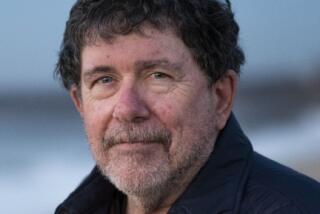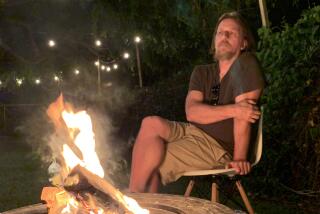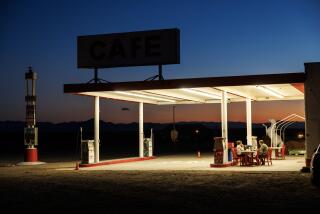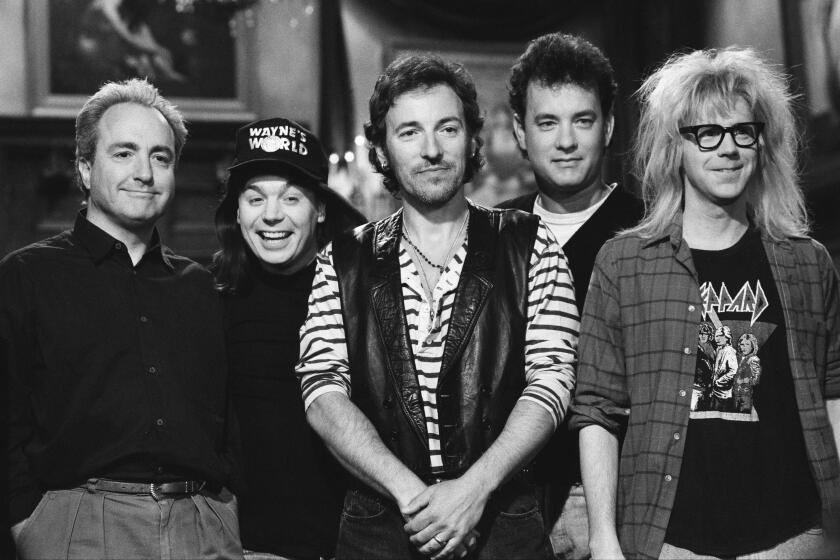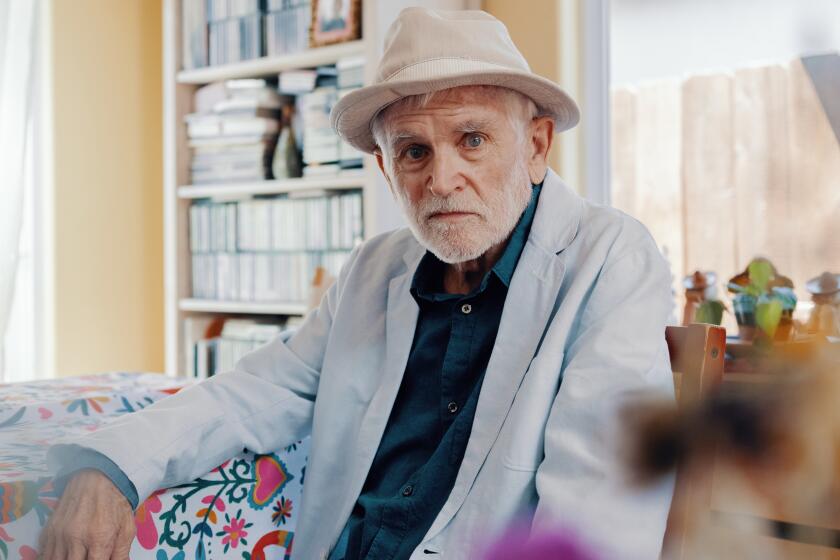Edward Abbey: Critic and Crusader
- Share via
Give me silence, water, hope.
Give me struggle, iron, volcanoes.
-- PABLO NERUDA
*
Strange to think of him now hiding out in the mysterious canyons of the Colorado Plateau like some solitary prospector from a B. Traven novel. Trim, leathery and artfully disheveled, complete with scraggly, unfashionable beard for more than 30 years, Edward Abbey presented himself as the literary watchdog of the arid American West, writing eight novels, dozens of travelogues and hundreds of essays, all aimed at the heart of the military-industrial complex President Dwight D. Eisenhower had warned about in his surprisingly frank farewell address in 1961. Abbey’s motto came from Walt Whitman--”resist much, obey little”--and he was delighted that everyone from the FBI to the Sierra Club derided him as a “Desert Anarchist.” Blessed with a wicked sense of humor and penchant for pranksterism, Abbey, who died in 1989 at age 62, carefully cultivated his ever-changing role as a stubborn provocateur, be it in the guise of a river rat, a learned scholar, gun-toting curmudgeon or a committed ecologist, personas he shuffled at whim, the only apparent constant being his good-natured sarcasm. But he also was always a disciplined writer, even while playing the robust outdoorsman obsessed with stopping the pillage of the American West. “We can have wilderness without freedom,” Abbey often said. “We can have wilderness without human life at all; but we cannot have freedom without wilderness.”
And he believed it. Throughout the Cold War era, no writer went further to defend the West’s natural places from strip-mining, speed-logging, power plants, oil companies, concrete dams, bombing ranges and strip malls than the sardonic Edward Abbey. Saguaro cactus were sacred to Abbey, not utility poles. His entire adult life was devoted to stopping the “Californicating” of the Four Corners states he considered home--Arizona, Colorado, New Mexico and Utah. Abbey was labeled the “Thoreau of the West” by novelist Larry McMurtry in an article in the Washington Post, a squib that remains the best shorthand description of this unorthodox yet meticulous literary craftsman.
Abbey rejected out of hand the notion that he was a “nature writer” along the lines of John McPhee or Annie Dillard, even if the untamed wilderness did serve as his lifelong muse; instead he fancied himself an old-fashioned American moralist, a Menckenesque maverick who kowtowed to no one in his quest to expose others’ treachery, hypocrisy and greed. It was the “moral duty” of a writer, Abbey insisted, to act as social critic of one’s country and culture and as such to speak for the voiceless. And so he did, especially in his memorable 1975 jeremiad, “The Monkey Wrench Gang,” with which he launched America’s “eco-defense” movement and rattled the cages of both Big Industry and Big Government.
Abbey was born to the task he would set himself on Jan. 29, 1927, in Home, Pa. As an adolescent, he became disgusted with the big lumber companies’ wanton destruction of the pristine Appalachian woodlands where he grew up hunting squirrels, collecting rocks and studying plants with the budding fervor of William Bartram, in what he called these “glens of mystery and shamanism.” Abbey fantasized that he was James Fenimore Cooper’s Natty Bumppo hiking the Adirondacks or Vachel Lindsay’s Johnny Appleseed planting seeds in the Ohio River Valley. His father, Paul Revere Abbey, was a hardscrabble farmer and occasional coal miner who revered the radical leaders of the Industrial Workers of the World, or Wobblies, as they were popularly known, such as “Big Bill” Haywood and Joe Hill.
The entire Abbey clan, in fact, was steeped in American folklore of the Daniel Boone variety: a deep love of the untrammeled frontier and an obsessive mistrust of Washington, D.C. Young Edward inherited from his father an uncouth and ornery disposition to take on the establishment with relish, and head-on: “Sentiment without action,” Abbey always said, “is the ruin of the soul.”
In the summer of 1944, the 17-year-old left Pennsylvania to seek the America he had heard about in Woody Guthrie songs and Carl Sandburg poems. He hitchhiked to Seattle, tramped down the Pacific Coast to San Francisco, ventured inland to the redwood forests of Yosemite, then took boxcars through the San Joaquin Valley, making his meager keep picking fruit or working in canneries along the way. His hobo holiday of storybook adventure and intoxicating freedom lost its allure only once, when he was arrested for vagrancy in Flagstaff, Ariz., and tossed into a jail like the common drunkards there. It only added to a coming-of-age experience of which Jack London would have approved.
*
The glories of the American West captivated the young Abbey. He stopped transfixed before the salmon-pink range lands of Navajo Country spreading out in front of him at sundown from various vistas: primordial sandstone cliffs, slickrock canyons, creosote bushes, hungry javelinas, Hopi arroyos, dusty cantinas, ash-throated flycatchers, turkey buzzards, loping coyotes, worn-edged arrowheads and all the wonders of the surreal region others mistook for barren. To Abbey, the Sonoran Desert and Death Valley were equally gorgeous dream lands where an unrelenting vermilion sun bleached the bones of dead cattle to a blinding white.
“There is no shortage of water in the desert but exactly the right amount,” Abbey would write later, “a perfect ratio of water to rock, of water to sand, ensuring that wide, free, open, generous spacing among plants and animals, homes and towns and cities, which makes the arid West so different from any other part of the nation. There is no lack of water here, unless you try to establish a city where no city should be.” In this forsaken, naked paradise, Abbey felt at peace. When he saw the great Colorado River tracing its ancient path near Needles, Calif., bringing its life-sustaining waters to the driest desert, Abbey wrote, “For the first time, I felt I was getting close to the West of my deepest imaginings, the place where the tangible and the mythical became the same.”
Shortly thereafter, the wanderer of the canyons was drafted into the U.S. Army; he spent the last year of World War II serving in Italy. Upon returning home, he headed straight for the Land of Enchantment, to the University of New Mexico, where he earned a bachelor’s degree in philosophy in 1951 and a master’s in 1956, the latter on a thesis titled “Anarchy and Morality of Violence,” in which he concluded that anarchism wasn’t really about military might, as the Bolshevik Revolution had been, but about opposition to, as Leo Tolstoy had put it, “the organized violence of the state.”
A self-styled flute-playing bum wandering his way through coffeehouses and university circles, Abbey was winked at as Albuquerque’s version of the ancient Greek cynic Diogenes, who allegedly abandoned all his possessions to live in a barrel and beg for his keep. Along the same lines, Abbey took to passionately denouncing the spoilers of the West: greedy developers, cattle ranchers, strip-mining outfits and the federal Bureau of Land Management. In response, the FBI began monitoring Abbey for possible communist activities and continued its surveillance of him for the next 37 years, eventually concluding that he was just a particularly stubborn and individualistic pacifist.
In 1954, Abbey published his first novel, “Jonathan Troy,” the story of a 19-year-old anarchist who alienates everyone he encounters while building the narrative theme that machines were ruining America. Over the next 10 years Abbey published six more books, including “The Brave Cowboy” (1956)--the tale of a barbed-wire-cutting maverick engaged in his own war with the U.S. government’s livestock grazing policy, which was made into the 1962 Kirk Douglas movie “Lonely Are the Brave”--and “Desert Solitaire” (1968), a first-person meditation based on the two seasons Abbey spent as a ranger at Utah’s Arches National Monument that the New York Times called “a passionately felt, deeply poetic book.” Abbey, in fact, wrote these volumes while working on and off for the U.S. Forest Service and Park Service over nearly two decades. “For most of these years,” he recalled, “I was living right around the official poverty line--I pounded in survey stakes before I ever got the notion to pull them out.”
Like Cervantes’ Don Quixote tilting at windmills, Abbey became notorious in the American Southwest for ransacking construction sites, denouncing ranchers as “welfare parasites” and shocking Easterners with his harsh conservationist prose. Unlike more conventional advocates of the burgeoning environmental movement of the early 1970s, however, the mischievous Abbey also flaunted his wildly contradictory impulses, such as roaring through the streets of Tucson in a vintage red Cadillac convertible with a plastic geranium stuck in the hood ornament and the radio blaring Mozart, Brahms or Waylon Jennings. As a professional nose tweaker, Abbey has a reason for his anti-growth prose and outlaw posture: to rage against the machine, to become the most ferocious defender of the American West since John Muir.
The windmill Abbey wanted to tear down most was the Glen Canyon Dam, constructed in 1962 just 60 miles north of the Grand Canyon, a 792,000-ton hydraulic monstrosity that had cost U.S. taxpayers $750 million to build. This concrete colossus had stemmed the natural flow of the Colorado River, desecrating the steep gorges of the magnificent Glen Canyon that Abbey imagined grander than all the cathedrals in Europe. Gone forever in the dam’s building were groves of cottonwood and thickets of tamarisk, wolves’ dens and eagles’ nests, natural sandstone spires and ancient archeological sites. In their place--man-made Lake Powell, a reservoir with a 1,800-mile shoreline that Abbey dubbed “the blue death.” Glen Canyon Dam was a pork barrel project ostensibly built to provide Los Angeles, Las Vegas and Phoenix with affordable electric power; in fact, it was an engineering abomination that destroyed an entire ecosystem. Even the dam’s conservative sponsor--Arizona Republican Sen. Barry Goldwater--would eventually admit that its construction had been a terrible mistake. “I think of the river as it was when I was a boy,” he said. “And that is the way I would like to see it again.”
*
It was with a bellyful of bile over Glen Canyon Dam that Abbey began writing “The Monkey Wrench Gang” in the early 1970s, putting black humor, theater gimmicks and clever characterizations together to form what would become a lasting cult classic. Drawing on facets of real people he knew, Abbey created an inspired cast of antiheroes: George Washington Hayduke, a former Green Beret medic in Vietnam who loved bombs, booze and the great outdoors almost as much as he despised developers; Doc Sarvis, a rich Albuquerque heart specialist whose hobby was burning billboards; Bonnie Abzug, a preternaturally sexy, sharp-tongued and endearing Jewish exile from the Bronx; and Seldom Seen Smith, a Mormon riverboat guide and watermelon rancher with three neglected wives.
In what Newsweek approvingly reviewed as an “ecological caper,” this gaggle of good-time anarchists mobilize themselves SWAT-like to harass power companies and logging conglomerates. Like their hero Neal Ludd--an early 19th century British weaver who provoked his countrymen to save their jobs by sabotaging machinery in the early days of the Industrial Revolution and to whom Abbey dedicated the novel--the Monkey Wrenchers develop into a charismatic clique of eco-nuisances who pour Karo syrup into bulldozers’ fuel tanks, snip barbed-wire fences and try to blow up a coal train, all in preparation for their real objective: dynamiting Glen Canyon Dam to bits. Their battle cry is “Keep it like it was.”
“The Monkey Wrench Gang” is far more than just a controversial book: It is revolutionary, anarchic, seditious and, in the wrong hands, dangerous. Although Abbey claimed it was just a work of fiction written to “entertain and amuse,” the novel was swiftly embraced by eco-activists frustrated with the timid approaches of mainstream environmental groups, such as the Sierra Club and the Audubon Society. To the radical-minded, Abbey’s picaresque novel was a call to action, brimming with the passion of Seldom Seen Smith, who knelt in the middle of Glen Canyon Dam and prayed: “Dear Old God. You know and I know what it was like here, before them bastards from Washington moved in and ruined it all. You remember the river, how fat and golden it was in June, when the big runoff come down from the Rockies? Remember the crick that come down through Bridge Canyon and Forbidden Canyon, how green and cool and clear it was? Remember the cataracts in Forty-Mile Canyon? Well, they flooded out about half of them. And part of the Escalante’s gone now. Are you listening to me? There’s something you can do for me, God. How about a little old precision-type earthquake right under this dam?”
Critic Donn Rawlings downplayed “The Monkey Wrench Gang” as a madcap tale of “symbolic aggression,” but to many shocked readers it was an irresponsible blueprint for terrorism akin to the white supremacist “The Turner Diaries” that supposedly sparked the 1995 bombing of the Murrah Federal Building in Oklahoma City. When asked if he was really advocating blowing up a dam, Abbey said, “No” but added that “if someone else wanted to do it, I’d be there holding a flashlight.” Failing to see his humor, Abbey’s detractors ignored an important point: Lovable pranksters in his novel kill only machines, not people, unlike the truly violent protagonists in such fictional works as Anthony Burgess’ “A Clockwork Orange” and Hubert Selby Jr.’s “Last Exit to Brooklyn.”
Astute reviewers saw “The Monkey Wrench Gang” for what it was: a wildly satiric, clever, postmodern pulp western that lampooned everything from the Lone Ranger to John Wayne to the women’s movement. No one claimed it a fictional masterwork--it isn’t--but like Harriet Beecher Stowe’s “Uncle Tom’s Cabin” and Upton Sinclair’s “The Jungle,” it was a rousing wake-up call, this time on behalf of endangered species and old-growth redwoods. Abbey wanted to return to a time when the American West was unmarred by industry and the ravages of so-called “progress.” To him, anarchy was democracy in action and his book’s eco-raiders were bold American patriots like those who participated in the Boston Tea Party or fought alongside Ethan Allen and his Green Mountain Boys. Following this tradition, Abbey’s fictional Monkey Wrenchers considered themselves justified in resorting to whatever means they found necessary to defend the Four Corners region from “desk-bound executives” with their “hearts in a safe deposit box and their eyes hypnotized by calculators.” It was civil disobedience in the grand tradition of Thoreau. After all, in “A Week on the Concord and Merrimack Rivers” (1849), Thoreau surprised readers by advocating the use of violence against a dam: “I for one am with thee, and who knows what may avail a crowbar against Billerica dam.”
After it was published, “The Monkey Wrench Gang” took on a life of its own. By the early 1980s many grass-roots environmentalists, like Abbey’s gang, had come to feel betrayed by large organizations such as the Sierra Club that had secretly negotiated the future of Glen Canyon in closed-door meetings with the U.S. Bureau of Reclamation during the Kennedy administration. Then, a real-life deal had been struck under which the bureau agreed to cancel its plans to build a dam in Dinosaur National Monument in Utah and Colorado in exchange for allowing one to be built in Glen Canyon. Disillusioned with the political process, a new militant group of eco-anarchists calling itself Earth First! adopted Abbey as its guru, “The Monkey Wrench Gang” as its bible and George Washington Hayduke’s credo--”Always pull up survey stakes anywhere you find them”--as its own.
*
From the start, Earth First! rankled the public and even other environmentalists. The group announced itself in 1981 by unfurling a 100-yard-long black plastic streamer designed to look like a deep crack down the face of Glen Canyon Dam--a scene taken straight from the opening pages of “The Monkey Wrench Gang.” It was a harmless guerrilla theater stunt, but the U.S. government chose to interpret it instead as a dangerous act by a new soft-core eco-terrorist group, setting off a swirl of controversy: The political right denounced Earth First! out of hand, while the left chuckled at its Yippie-ish antics. A 1991 Los Angeles Times headline summed up the dueling perceptions: “Terrorists or Saviors?”
Many applauded the group’s bold antics, which ranged from blocking the paths of bulldozers in Nevada to sitting in trees slated for clear-cutting in California to burying salt in dirt airstrips in Idaho so that deer and elk would dig them up beyond usefulness. Arrested in Wyoming, jailed in Montana and beaten in Oregon, the Earth First!ers made Sierra Club activists look like Junior Leaguers on a do-gooder field trip. Abbey’s volatile Hayduke--modeled after his real-life chum Doug Peacock, who after serving in Vietnam opted to live among the grizzly bears in Yellowstone National Park--became Earth First!’s avatar, a fearless eco-David slinging rocks at the mechanized Goliaths. David Foreman, one of the Earth First! founders who helped unfurl the phony crack down Glen Canyon, wrote an Abbeyesque sabotage primer titled “Eco-Defense: A Field Guide to Monkey Wrenching.”
As might be expected, the FBI had continued monitoring these latter-day Luddites, infiltrating the group, collecting 1,200 hours of tape-recorded conversations among its members and arresting a number of them for spiking trees, cutting power lines or destroying bulldozers. Abbey never joined Earth First!, refusing to take responsibility for its high-profile vandalism. Yet he took pride in this new generation of Monkey Wrenchers and befriended some of their leaders, at whose request he occasionally contributed brief bursts of wisdom to the Earth First! newspaper.
“Enjoy yourself,” he instructed its readers in one such piece. “Keep your brain in your head and your head firmly attached to your body, the body active and alive, and I promise you one sweet victory over our enemies.”
Twenty-five years after its initial publication, some 700,000 paperback copies of “The Monkey Wrench Gang” have been sold, even though Abbey made The New Yorker and Paris Review crowds uncomfortable. He called the revered Tom Wolfe a “faggoty fascist fop” and the sainted John Updike a boring armchair purveyor of “suburban soap operas,” yet his die-hard fans included such well-known writers as Joan Didion, Wendell Berry, Thomas Pynchon, Cormac McCarthy, Dillard, Hunter S. Thompson, McMurtry and Thomas McGuane. The late Wallace Stegner, in fact, proclaimed that Abbey presented the “stinger of a scorpion” and was the “most effective publicist of the West’s curious desire to rape itself since Bernard DeVoto.”
The American Southwest has produced other fine writers--Mary Austin, Oliver LaFarge and Barbara Kingsolver come to mind--but none has piqued readers’ imaginations to the same extent as Edward Abbey. And in his 20th and last book--”Hayduke Lives!,” a posthumous sequel to “The Monkey Wrench Gang”--Abbey has the last word: “Anyone who takes this book seriously will be shot. Anyone who does not take it seriously will be buried alive by a Mitsubishi bulldozer.”
In “Epitaph for a Desert Anarchist: The Life and Legacy of Edward Abbey,” journalist James Bishop Jr. recounts a letter that William Butler Yeats wrote to Oscar Wilde stating that he “envied those men who become mythological while still living.” “The Monkey Wrench Gang” transformed Abbey from exquisite chronicler of Utah’s Canyonlands to full-fledged folk figure, the literary equivalent of a “green” Jesse James. Even in death, mystery surrounded Abbey, and in radical environmental circles, many believe he is still alive. Scrawled on bathroom walls and campground bulletin boards throughout the West, the phrase “Abbey Lives!” abounds.
I predict that in the coming years the legends of Edward Abbey and “The Monkey Wrench Gang” will grow in popularity as the environmental movement swells in numbers, Detroit auto makers launch a “clean revolution” by phasing out the internal combustion engine in favor of hydrogen fuel cells, and the U.S. government tears down dams like Glen Canyon that should never have been built. Like Rachel Carson’s “Silent Spring,” Abbey’s notorious novel will be savored because of its proactive defense of nature in an era of dangerous hyper-industrialism.
To Abbey, “The Monkey Wrench Gang,” however, was more in line with Tom Paine’s “Common Sense.” It was written to be read in sawdust taverns and isolated cabins, hiking trails and humming factories. Abbey never cared whether it was deemed a work of art by the New York Times or Alfred Kazin; it was made to jar the soul, and even his most severe critics must grant that, at least in that regard, “The Monkey Wrench Gang” was a whopping success.
More to Read
Sign up for our Book Club newsletter
Get the latest news, events and more from the Los Angeles Times Book Club, and help us get L.A. reading and talking.
You may occasionally receive promotional content from the Los Angeles Times.
